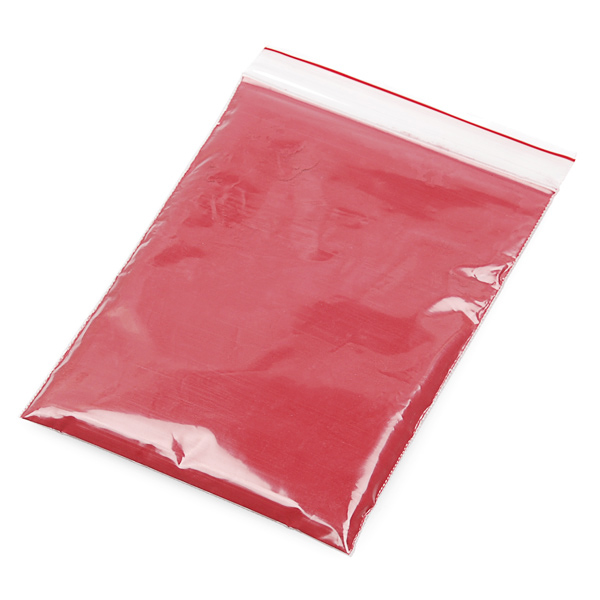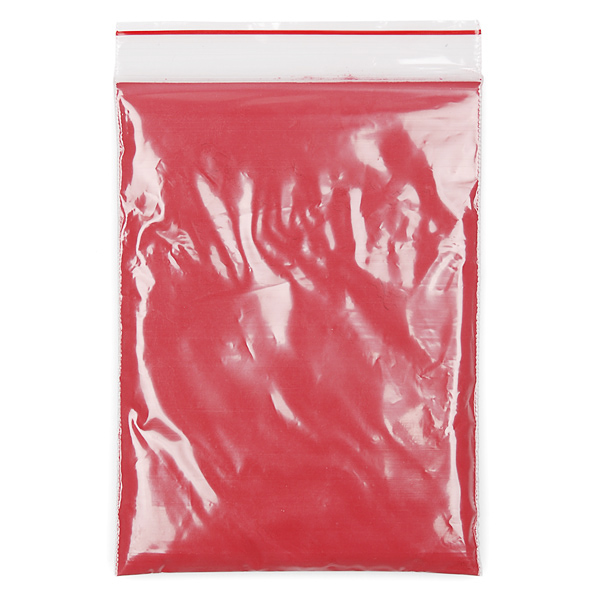Thermochromatic Pigment - Red (20g)
We've all seen toys and things that change color when you run them under warm water or heat them up in the sun. Some of us were especially mesmerized and had to find out what made them do that. It turns out that this is a property called "thermochromism" and it can be implemented in a number of ways. This particular pigment is a Leuco dye type pigment which is made up of a mixture of Leuco dyes, weak acids and salts microencapsulated in polymer. Sounds complicated, right? Nah, it's not so bad.
All you need to know is that this is a very fine, colored powder that changes to a clear powder when you heat it to about 92°F (33°C). This is really cool for a lot of reasons. You can mix this pigment with paint to create thermochromatic paint for craft projects or to make temperature indicators. It mixes with Sugru and Polymorph as well, rendering them both thermochromatic. Use a controllable electric heating source and you could even build a thermochromatic display!
This pigment comes in a 20g bag, which is more than enough to play with and just enough for a good sized project (depending on what you're doing with it). Careful not to overheat the pigment as temperatures over 200°C can cause irreversible damage to most Leuco dyes.
- Red at Room Temperature
- Turns Clear at Around 92°F (33°C)
- Mix with paint, glue, resin, Polymorph, Sugru, etc.
Thermochromatic Pigment - Red (20g) Product Help and Resources
21st Century Fashion Kit: Electrochromatic Circuits
November 5, 2014
Diana Eng walks you through a magically appearing design made with an thermochromatic pigment.
Electronic E-craft Terrarium
January 21, 2016
A guest tutorial on an Electronic Terrarium from the Performative Sculpture class of Parsons DT.
Core Skill: DIY
Whether it's for assembling a kit, hacking an enclosure, or creating your own parts; the DIY skill is all about knowing how to use tools and the techniques associated with them.
Skill Level: Noob - Basic assembly is required. You may need to provide your own basic tools like a screwdriver, hammer or scissors. Power tools or custom parts are not required. Instructions will be included and easy to follow. Sewing may be required, but only with included patterns.
See all skill levels
Comments
Looking for answers to technical questions?
We welcome your comments and suggestions below. However, if you are looking for solutions to technical questions please see our Technical Assistance page.
Customer Reviews
4 out of 5
Based on 1 ratings:
A hot surface warning
I bought this to be used on some power resistors that I use to simulate a heavy electrical load. On occasion one of these will be left powered for quite a bit of time and the intent was to be able to tell at a glance whether I should avoid touching the resistor or not. As advertised, the pigment turns clear when it is hot and turns back to red when not hot. That part works really well. The only problem I have with this stuff is it changes at too low a temperature, which I knew it would when I bought it-just wish Sparkfun offered a higher temp version of this stuff, in any color. Originally I was hoping to get 50 degrees C or so. I don't need it bad enough to buy it by the 50 gallon drum. The packet I ordered is enough for a couple of lifetimes of my intended use, so to get my monie's worth Sparkfun will have to find some way of extending a lifetime ;)
The way I used it was to place a tiny amount of the powder on the end of a toothpick and mix it into a small pool of clear finger nail polish sitting on a piece of cardboard. This was enough to paint a generous blob onto 5 aluminum framed power resistors using the toothpick.
Bit of advice, if you are male, try to avoid asking any of the women in the office for finger nail polish-they may be inclined to have fun at your expense ;)



-------------------- Tech Support Tips/Troubleshooting/Common Issues --------------------
Additional Tutorials, Demos, and Tests
21st Century Fashion Kit: Electrochromatic Circuits [ https://learn.sparkfun.com/tutorials/21st-century-fashion-kit-electrochromatic-circuits ]
21s Century Century Fashion Kit demo with "Dangerous Box" => [ https://youtu.be/Wl4574fxfEo?t=1m13s ] . Warning: Please do not attach a RC LiPo battery directly to a Peltier Cooler without a microcontroller, transistor, and heat sink to manage the power and regulate the heat. The demo video demonstrates how the thermochromatic paint turns clear when the mixture is heated and opaque when it is reheated.
MIT: Dena Molnar and Nicole Tariverdian's Crafting Material Interfaces [ http://courses.media.mit.edu/2011fall/mass62/index.html%3Fp=1828.html#more-1828 ]
Using Thermochromatic Paint with Fabric [ [ http://www.quiltingdaily.com/wp-content/uploads/QATV_1313-3_SlebodaThermochromic.pdf ]
Lynsey Calder: Thermochromic heated lozenge [ http://etextile-summercamp.org/2013/?p=783 ]
Instructables: Warming Up [ http://www.instructables.com/id/Warming-up/ ]
I'm hoping there are plans to use this on the Sparkfun coffee mugs.
this stuff i awesome!!!
The MSDS is lacking in the "what the heck is in this stuff" department... my wife has shown me some clear hair dye that Joico makes ... http://www.sleekhair.com/joi12-clear-mixer.html and I am 50:50 on an experiment... but I need to know if this has any metal components as using anything metallic when coloring hair, if the color that contains a developer, will have a chemical reaction with metal, and in rare cases that chemical reaction can cause the hair to dissolve.
Hi, i want to make a print on t-shirt with this red. I dont know how i will use this production. please help.
try Speedball's Acrylic Extender Base on a test swatch....
Hi, loved the product and couldn´t help to get it but ... have a question, how is the process to follow in order to dye a garment properlly?
thanx :)
It's a weird, new material. Additionally, it's a pigment, not a dye, and doesn't exactly dissolve in water. You may be able to dye with it, but there's no guarantee, and it will definitely take some experimentation. It looks like Dena Molnar and Nicole Tariverdian at MIT had some luck with this; check out their write-up here. Good luck! And if you learn anything new or get awesome results, share them here!
How much paint does 20g mix into?
This will depend on the paint you're mixing it with, and how much of a color difference you want to see. Experimenting will give you the best answers for that :)
In the MSDS it says SOLUBILITY IN WATER Dispersible. Does that mean that you could make color changing liquid?
It means it disperses, not dissolves (think colloid).
So I guess color changing Mayonnaise then. :-)
ETA: Scratch that, from the MDS
INGESTION Induce vomiting immediately. See a physician. :-(
This reminds me of those Hypercolor shirts back in the 1990s, and those HotWheel cars that could change colors in warm water. Neat stuff!